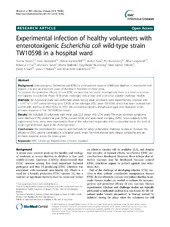| dc.contributor.author | Skrede, Steinar | en_US |
| dc.contributor.author | Steinsland, Hans | en_US |
| dc.contributor.author | Sommerfelt, Halvor | en_US |
| dc.contributor.author | Aase, Audun | en_US |
| dc.contributor.author | Brandtzaeg, Per | en_US |
| dc.contributor.author | Langeland, Nina | en_US |
| dc.contributor.author | Cox, Rebecca Jane | en_US |
| dc.contributor.author | Sævik, Marianne | en_US |
| dc.contributor.author | Wallevik, Marita | en_US |
| dc.contributor.author | Skutlaberg, Dag Harald | en_US |
| dc.contributor.author | Tellevik, Marit Gjerde | en_US |
| dc.contributor.author | Sack, David A. | en_US |
| dc.contributor.author | Nataro, James P. | en_US |
| dc.contributor.author | Guttormsen, Anne Berit | en_US |
| dc.date.accessioned | 2014-09-16T07:42:44Z | |
| dc.date.available | 2014-09-16T07:42:44Z | |
| dc.date.issued | 2014-09-04 | eng |
| dc.identifier.issn | 1471-2334 | |
| dc.identifier.uri | https://hdl.handle.net/1956/8477 | |
| dc.description.abstract | Background: Enterotoxigenic Escherichia coli (ETEC) is an important cause of childhood diarrhea in resource-limited regions. It is also an important cause of diarrhea in travellers to these areas. To evaluate the protective efficacy of new ETEC vaccines that are under development, there is a need to increase the capacity to undertake Phase IIB (human challenge) clinical trials and to develop suitable challenge models. Methods: An in-hospital study was performed where fasting adult volunteers were experimentally infected with 1 × 106 to 1 × 109 colony forming units (CFUs) of the wild-type ETEC strain TW10598, which had been isolated from a child with diarrhea in West Africa in 1997. We recorded symptoms and physical signs and measured serum immune response to the TW10598 bacterium. Results: We included 30 volunteers with mean age 22.8 (range 19.8, 27.4) years. The most common symptoms were diarrhea (77%), abdominal pain (67%), nausea (63%), and abdominal cramping (53%). Seven subjects (23%) experienced fever, none were hypotensive. Most of the volunteers responded with a substantial rise in the level of serum IgA antibodies against the challenge strain. Conclusions: We established the capacity and methods for safely undertaking challenge studies to measure the efficacy of ETEC vaccine candidates in a hospital ward. Strain TW10598 elicited both clinical symptoms and an immune response across the doses given. | en_US |
| dc.language.iso | eng | eng |
| dc.publisher | BioMed Central | eng |
| dc.rights | Attribution CC BY | eng |
| dc.rights.uri | http://creativecommons.org/licenses/by/4.0 | eng |
| dc.subject | ETEC | eng |
| dc.subject | Challenge | eng |
| dc.subject | Experimental infection | eng |
| dc.subject | Inpatient | eng |
| dc.title | Experimental infection of healthy volunteers with enterotoxigenic Escherichia coli wild-type strain TW10598 in a hospital ward | en_US |
| dc.type | Peer reviewed | |
| dc.type | Journal article | |
| dc.date.updated | 2014-09-13T23:02:52Z | |
| dc.description.version | publishedVersion | en_US |
| dc.rights.holder | Copyright 2014 Skrede et al.; licensee BioMed Central Ltd. | |
| dc.rights.holder | Steinar Skrede et al.; licensee BioMed Central Ltd. | |
| dc.source.articlenumber | 482 | |
| dc.identifier.doi | https://doi.org/10.1186/1471-2334-14-482 | |
| dc.identifier.cristin | 1166141 | |
| dc.source.journal | BMC Infectious Diseases | |
| dc.source.40 | 14 | |

